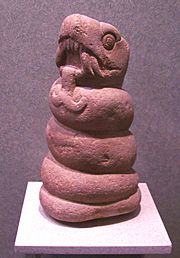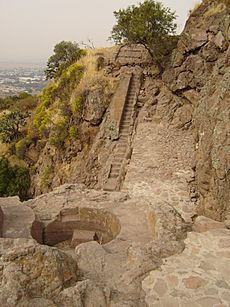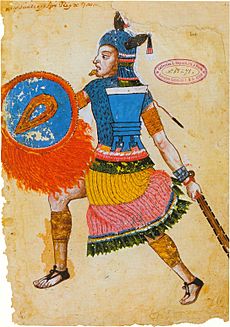Tetzcoco (altepetl) facts for kids
Quick facts for kids
Tetzcoco
|
|||||||
|---|---|---|---|---|---|---|---|
| 1200–1521 | |||||||

The Valley of Mexico at the time of the Spanish conquest, showing Texcoco in relation to Tenochtitlan and other cities in the Valley of Mexico.
|
|||||||
| Capital | Tetzcoco | ||||||
| Common languages | Classical Nahuatl | ||||||
| Religion | Aztec religion | ||||||
| Government | Monarchy | ||||||
| Historical era | Pre-Columbian | ||||||
|
• Established
|
1200 | ||||||
| 1521 | |||||||
|
|||||||
Tetzcoco (pronounced Tet-SKO-ko) was a very important city-state in ancient Mexico. It was located in the central part of Mesoamerica, a region that includes modern-day Mexico and Central America. Tetzcoco was built on the eastern side of Lake Texcoco in the Valley of Mexico. It was northeast of Tenochtitlan, which was the capital city of the Aztec Empire.
Today, the area where ancient Tetzcoco once stood is part of the modern city of Texcoco de Mora in Mexico. It is also close to Mexico City.
Tetzcoco is most famous for being a key member of the Aztec Triple Alliance. This was a powerful group of three city-states. When the Spanish arrived, Tetzcoco was one of the biggest and most respected cities in central Mexico. Only the Aztec capital, Tenochtitlan, was larger. Experts believe that before the Spanish arrived, Tetzcoco had over 24,000 people and covered an area of 450 hectares (about 1,100 acres).
The people of Tetzcoco were called Tetzcocatl (for one person) or Tetzcocah (for many people).
Contents
History of Tetzcoco
Tetzcoco was founded in the 12th century, around the year 1100s. It was built on the eastern shore of Lake Texcoco, likely by a group of people called the Chichimecs. Around 1337, another group, the Acolhua, with help from the Tepanec people, took control of Tetzcoco. Tetzcoco then became the main city for the Acolhua, taking over from Coatlinchan.
In 1418, Ixtlilxochitl I, who was the ruler (called a tlatoani) of Tetzcoco, was removed from power. This happened because Tezozomoc from Azcapotzalco defeated him. Ten years later, in 1428, Ixtlilxochitl's son, Nezahualcoyotl, teamed up with the Mexica people (who were the Aztecs). Together, they defeated Tezozomoc's son, Maxtla.
After this victory, Tetzcoco, the Aztecs of Tenochtitlan, and the Tepanecs of Tlacopan formed a strong partnership. This group became known as the Triple Alliance. Tetzcoco became the second most important city in the growing Aztec Empire. It was agreed that Tetzcoco would receive two-fifths (40%) of all the tribute (taxes or payments) collected by the alliance. Tlacopan received one-fifth (20%), and Tenochtitlan received the remaining two-fifths.
Tetzcoco was also famous for being a center of learning and knowledge within the empire. It had a well-known library with many books from older Mesoamerican civilizations.

Royal Palace and Gardens
The royal palace in Tetzcoco was built near the hill of Tetzcotzingo. It was an amazing place with aqueducts (water channels), baths, beautiful gardens, and many rooms. There were over 300 separate chambers in the palace.
The palace gardens were like a huge collection of plants. They had plants from all over the Aztec Empire and even from faraway lands that traded with the empire. Some parts of these gardens still exist today. Scientists have studied them and found that the layout was carefully planned. It was designed to line up with important events in the sky, especially related to the planet Venus. This was a more complex design than just lining up with north, south, east, and west.
The water for these gardens came from springs located beyond the mountains to the east of Tetzcoco. This water was brought to the city through canals carved into the rock. In some places, rock staircases were used to create waterfalls. After crossing the mountains, the canals continued downhill. They reached a deep canyon that blocked the path to the city. To solve this, Nezahualcoyotl ordered the canyon to be filled with tons of rocks and stones. This created one of the biggest aqueducts in the ancient Americas.
Sacred Hill of Tetzcotzingo
The entire hill of Tetzcotzingo was also part of this amazing water system. The designers turned it into a special, sacred place for the rain god Tláloc. It had waterfalls, and even exotic animals and birds.
At the very top of the mountain, a shrine was built for the god. It was surrounded by hanging gardens. To reach this shrine, people had to climb a long flight of 520 marble steps. This number was very important in Aztec beliefs. According to their mythology, the gods had a chance to destroy humanity every 52 years.
Rulers of Tetzcoco
The first ruler of Tetzcoco was Xolotl, who is said to have founded the city in 1115 AD. He ruled until 1232. After him came several other rulers, including:
- Nopaltzin (1232–1263)
- Tlotzin (1263–1298)
- Quinatzin (1298–1357)
- Techotlalazin (1357–1409)
- Ixlilxochitl (1409–1418)
- Nezahualcoyotl (1420–1472)
- Nezahualpilli (1472–1516)
- Cacama (1517–1519)
- Coanchochtzin (1520–1521)
- Don Fernando Ixtlilxochitl (1521–1531)
Nezahualcoyotl (1403–1473) was a very famous ruler of Tetzcoco. He was known as a talented poet, a wise thinker, and a great supporter of the arts. He also had a huge garden with many different plants and animals. These specimens came from all over the Aztec Empire and from other lands that traded with the empire.
Nezahualcoyotl's son, Nezahualpilli (1464–1515), continued his father's tradition of supporting artists and learning.
In 1520, the troops led by Hernán Cortés (a Spanish conqueror) took control of Tetzcoco. They killed Cacamatzin, who was Nezahualpilli's son and the last independent ruler of Tetzcoco. Cortés then put Ixtlilxochitl II in charge as a ruler who would follow Spanish orders. Cortés used Tetzcoco as his main base and had Tetzcocan warriors help him in the Siege of Tenochtitlan.
After the fall of Tenochtitlan, the Spanish still recognized Tetzcoco as an important city. They called it a "ciudad" (city) and changed its name to "Texcoco." The royal family of Tetzcoco continued to rule for some time, following their traditional ways of choosing new leaders.
However, a terrible outbreak of smallpox happened in Texcoco shortly after the Spanish-Aztec War. This disease caused the city's population to drop sharply.
Later History
From 1827 to 1830, Texcoco served as the capital city of the State of Mexico.
See also
 In Spanish: Tetzcuco para niños
In Spanish: Tetzcuco para niños




